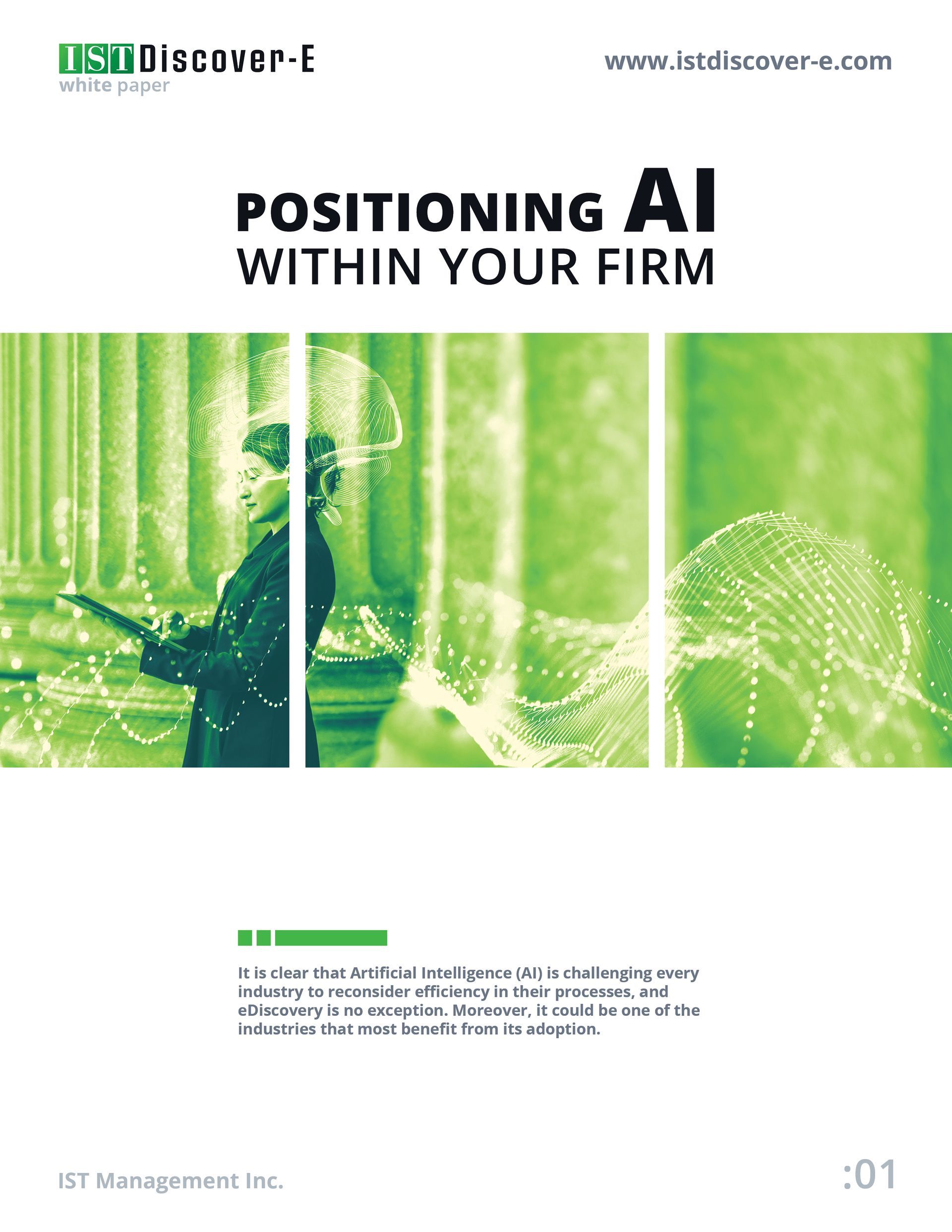Positioning AI Within Your Firm
It is clear that Artificial Intelligence (AI) is challenging every industry to reconsider efficiency in their processes, and eDiscovery is no exception. Moreover, it could be one of the industries that most benefit from its adoption. With a reputation for being slow to implement new technologies, one can expect legal industries to be hesitant. Firms must consider the ethical implications of using AI tools and the additional cost and work to onboard. For many, these considerations pump the breaks for further review. Still, eDiscovery will only get more complex; without the most cutting-edge technology, it will cost more.
As data spreads, the manual power to source and accurately review documents demands perfection from attorneys, and from firms, larger teams, or slower deadlines. To counter this growing obstacle, firms should be proactive in understanding how to utilize AI safely and defensibly, and better yet, regard how it can enhance strategies.
What Could Happen? The Bad
Paramount among the concerns of AI adoption are accuracy and defensibility and with good reason. Litigation can be costly and stressful for clients, requiring those handling the matter to be thorough and dedicated. Yielding a portion of that responsibility to technology depends on greater oversight and due diligence from attorneys to ensure a successful product.
Recently, A New York lawyer utilized the AI tool, ChatGPT to draft a brief, and later realized the tool falsely cited cases that did not exist. This negligence resulted in court-imposed sanctions, fines, and additional processes for counsel entering litigation, such as submitting generative AI certifications when submitting documents, attesting to not using generative AI, or verifying human quality control. Yes, AI was the direct cause of error in this instance, but the overall fault belongs to the attorney's oversight.
AI tools are imperfect and require advanced monitoring and training to work correctly. Studies cite inherent bias, cybersecurity gaps, and lack of transparency as potential risks. Further, one must always question its ability to comprehend complex concepts or interpret case law. Because of this, the workforce required to use AI responsibly may not be worth the preparation and considerable cost for some firms.
Job replacement is a common myth of AI. In a recent report, Goldman Sachs predicted that AI could replace 300 million jobs, alerting many to fear its application. However, this study did not account for the many jobs that will likely arise due to its implementation. With new roles to train and monitor performance, AI can be a supportive addition to a firm, helping drive business and build greater efficiency rather than a replacement for talent.
What Could Happen? The Good
The potential workflow power an AI tool can provide is limitless and determined by the needs of the firm wielding it. It can streamline time-consuming tasks, like research and content generation, helping lawyers digest complex information and build strategies faster. It can draft documents accurately and quickly, and enhance Document Review by reducing documents in a dataset. The possibilities for improving timely tasks are numerous, allowing lawyers to focus more on strategy, risk mitigation, and case preparation, all of which AI tools can assist.
Predictive analytics can help teams decide on settling or proceeding with litigation by analyzing historical case data to predict outcomes. This added perspective can help resource allocation and provide data-driven reasoning to a team's action plan. AI can also support due diligence during the discovery phase, identifying critical information before engaging in litigation.
To successfully adapt it to a firm's workflow, it requires human guidance to train and monitor its performance, requiring a cost-benefit analysis for those considering investing. Still, even with the added initial cost, expanding workflows and thoughtfully strategizing is invaluable to an operation's quality of service.
Ensuring Success
For any considering adding AI tools, keep in mind the following:
- Before adoption, create policies and training for using this technology. Consult with external partners and subject-matter experts on emerging technologies to ensure it is the right tool for your operation. Evaluate ethical obligations with technology, security, and privacy.
- Mitigate risk by fact-checking and performing due diligence. Often the fault in AI tools is in human negligence, so factor the added management in overseeing new tools. Otherwise, you could be penalized with court sanctions, ethical violations, reputational harm, and lost business.
- There are more
AI tools than you realize to accomplish specific litigation tasks. Research what is most advantageous for your operation.
Limitations will always exist in technology, and the most crucial consideration in AI adoption is understanding the responsibility of the one wielding it. Staying ahead of trends and understanding their impact on the legal world will separate strategic firms from the stagnant. As the cost of litigation rises and data grows, including these adaptive tools will help firms stay competitive and relevant to what the market expects and, hopefully, less fearful of how it will influence our future industry.




